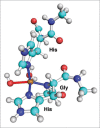Insights into prion protein function from atomistic simulations
- PMID: 20118658
- PMCID: PMC2850415
- DOI: 10.4161/pri.4.1.10969
Insights into prion protein function from atomistic simulations
Abstract
Computer simulations are a powerful tool for studies of biological systems. They have often been used to study prion protein (PrP), a protein responsible for neurodegenerative diseases, which include "mad cow disease" in cattle and Creutzfeldt-Jacob disease in humans. An important aspect of the prion protein is its interaction with copper ion, which is thought to be relevant for PrP's yet undetermined function and also potentially play a role in prion diseases. for studies of copper attachment to the prion protein, computer simulations have often been used to complement experimental data and to obtain binding structures of Cu-PrP complexes. This paper summarizes the results of recent ab initio calculations of copper-prion protein interactions focusing on the recently discovered concentration-dependent binding modes in the octarepeat region of this protein. In addition to determining the binding structures, computer simulations were also used to make predictions about PrP's function and the role of copper in prion diseases. The results demonstrate the predictive power and applicability of ab initio simulations for studies of metal-biomolecular complexes.
Figures




Similar articles
-
Ab initio simulations of Cu binding sites on the N-terminal region of prion protein.J Biol Inorg Chem. 2007 May;12(4):571-83. doi: 10.1007/s00775-007-0218-x. Epub 2007 Feb 27. J Biol Inorg Chem. 2007. PMID: 17333299
-
Copper and the prion protein: methods, structures, function, and disease.Annu Rev Phys Chem. 2007;58:299-320. doi: 10.1146/annurev.physchem.58.032806.104657. Annu Rev Phys Chem. 2007. PMID: 17076634 Free PMC article. Review.
-
The non-octarepeat copper binding site of the prion protein is a key regulator of prion conversion.Sci Rep. 2015 Oct 20;5:15253. doi: 10.1038/srep15253. Sci Rep. 2015. PMID: 26482532 Free PMC article.
-
Early onset prion disease from octarepeat expansion correlates with copper binding properties.PLoS Pathog. 2009 Apr;5(4):e1000390. doi: 10.1371/journal.ppat.1000390. Epub 2009 Apr 17. PLoS Pathog. 2009. PMID: 19381258 Free PMC article.
-
Copper binding in the prion protein.Acc Chem Res. 2004 Feb;37(2):79-85. doi: 10.1021/ar0301678. Acc Chem Res. 2004. PMID: 14967054 Free PMC article. Review.
Cited by
-
Mechanism of copper(II)-induced misfolding of Parkinson's disease protein.Sci Rep. 2011;1:11. doi: 10.1038/srep00011. Epub 2011 Jun 14. Sci Rep. 2011. PMID: 22355530 Free PMC article.
References
-
- Prusiner SB. Prion Diseases and the BSE Crisis. Science. 1997;278:245–251. - PubMed
-
- Baxa U, Cassese T, Kajava AV, Steven AC. Structure, function and amyloidogenesis of fungal prions: filament polymorphism and prion variants. Adv Protein Chem. 2006;73:125–180. - PubMed
-
- Klamt F, Dal-Pizzol F, Conte da Frota ML, Walz R, Andrades ME, da Silva EG, et al. Imbalance of antioxidant defense in mice lacking cellular prion protein. Free Radic Biol Med. 2001;30:1137–1144. - PubMed
-
- Vassallo N, Herms J. Cellular prion protein function in copper homeostasis and redox signalling at the synapse. J Neurochem. 2003;86:538–544. - PubMed
Publication types
MeSH terms
Substances
LinkOut - more resources
Full Text Sources
Research Materials
